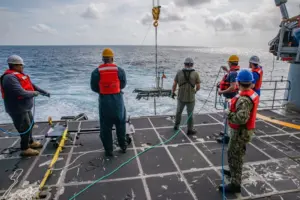The Navy and Military Sealift Command launched a Wave Glider unmanned surface vehicle (USV) from an expeditionary fast transport ship ahead of a large multinational maritime exercise in Central and South America.
Sailors, civilian mariners and contractors launched the USV from the Spearhead-class USNS
Burlington (T-EPF-10) on June 30, ahead of the international UNITAS exercise that began on July 11 and is expected to run through July 21.

The launch occurred while EPF-10 was traveling to Cartagena, Colombia. The catamaran hull EPF ships aim to transport Army and Marine Corps units and vehicles with a ramp capable of being used in austere piers and via a helicopter flight deck.
Boeing’s [BA] Liquid Robotics builds the autonomous Wave Glider. It is powered by wave and solar energy, which can operate for up to a year without fuel, according to the company website.
Wave power means the motion from vertical waves is converted into forward thrusts. During UNITAS, the Navy said Wave Glider will provide maritime domain awareness to operations in the at-sea exercise area.
The Navy said the Wave Glider will be one of several unmanned systems in the exercise as part of U.S. Naval Forces Southern Command/U.S. 4th Fleet’s Unmanned Integration Campaign.
The service said the campaign aims to deploy and integrate unmanned systems and artificial intelligence tools into operations “which will bolster the Navy’s Marine Domain Awareness (MDA), counter-narcotics (CN) efforts and information sharing with partner nations.”
In April, Navy leaders announced the expansion of unmanned systems testing into the 4th Fleet starting with UNITAS, building on the work of Central Command’s Task Force 59 (Defense Daily, April 4).
The U.S-sponsored UNITAS is the longest-running annual multinational maritime exercise in the world, starting in 1960.
The service said the objective of the 4th Fleet Unmanned Integration Campaign is to ultimately help scale up unmanned systems to the fleet level while also developing tactics, techniques, and procedures leading to the U.S. Navy’s goal of a Hybrid Fleet in the 2030s.
“UNITAS is so unique and full of opportunities for innovation, providing an ideal location to experiment with service concepts and conduct combined training while close to home and in a permissive environment,” Cmdr. Michael Fleck, Burlington’s Military Detachment officer in charge, said in a statement.